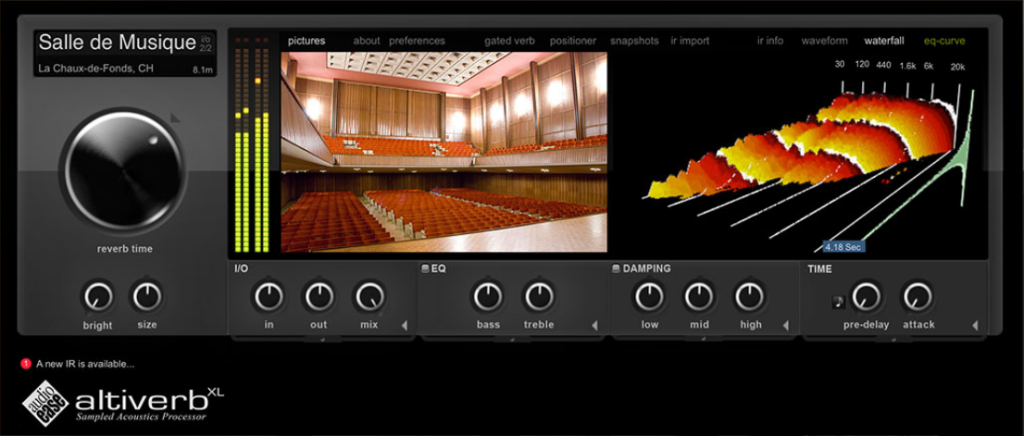Based on capturing the temporal/spectral feedback of any space (or resonant enclosure), retrieved from a complete temporal (transient impulse) or spectral (white noise, sweep signal) excitation. So, “combining” a dry signal with the captured excitation feedback from a space allows us to obtain the original dry signal reverbed with the sampled space characteristics.
This “combination” actually is:
- A convolution in the temporal domain.
- A multiplication in the frequency domain.
Convolutive reverb pros:
- Fidelity, transparenciy, realism.
- Creativity (convoluting “weird” unusual spaces)
Convolutive reverb pros:
- May lack character/personality.
- Too-generic response
- Computationally intensive (DSP)
IR (Impulse Response)
Temporal feedback response of space to the particular excitation of an ideal Dirac delta function δ(x). This function has an infinite energy value at a x(t) = 0 and zero anytime else.
For any causal lineal and time-invariant system (LTI system), as is the case of a room or resonant system, the impulse response contains all the information about the system behaviour’s and allows to calculate and retrieve its feedback (actually the room reverberation) to any input signal.

Problem/limitation of using an IR:
- Non perfectly implementable: balloons, firecrackers, gunshot, are approximations.
- Finite energy transforms in a non-completely uniform frequency response excitation
- Measurements are not 100% repeatable, huge dynamics needed in the excitation/measurement equipment
Solution:
- A method is needed to extend the excitation time and undo by deconvolution this procedure after the measurement (indirect methods)
- Indirect methods:
- MLS (Maximum Length Sequences), a binary pseudo-random sequence of white or pink noise (the latter has better SNR (signal-to-noise ratio) at LF).
- ESS (Exponential Sine Sweep), 10-30s linear or logarithmic broadband (20Hz-20Khz) sweeps. For acoustic measurements a pink noise logarithmic sweep is preferred. Thus, as long as the chirp signal is not too fast, the inverse filter needed for deconvolution is the original chirp inverted in the time domain, modified by a +6 dB/octave increase. The longer the chirp, the better the measurement SNR

CONVOLUTION
The convolution between two signal represents their superposition range (here, in the temporal domain), where both signals “roll together” or “fold together”. We can conceptually talk of a measurement of the degree of temporal coincidence between the two signals, the exciting one (dry sound x(t)) and the excited (room’s impulse response h(t)).

DECONVOLUTION
Deconvolution is an algorithm-based process to reverse convolution effects on recorded data, allows retrieval, from a convoluted result, of one of the original values used for the calculation of convolution – in our case, the impulse response h[n].
The objective is to create an inverse filter F-1(w) = 1/F(w) which is to be convolved with the recorded “wet” ESS, r(t), yielding the impulse response h(t) as h(t) = f-1(t)*r(t) or H[w]=R[w].F[w].
The time-reversed ESS signal f–1 (t) is such that f-1(t)*f(t) = F-1 [w].F[w] = 1 , yielding a flat spectrogram and thus revealing h(t) or H[w] properties.
Some softwares deconvolute the recording of a chirp signal x[n] played back in/through a space/device of interest with the time-reversed signal of the original chirp, to retrieve the space/device impulse response h[n] (Voxengo Deconvolver, Altiverb IR Preprocessor, etc.)

A quick look of how to convolve a reverb.
Equipment needed:
- An interesting space: room, hall, cabinet, sound device (compressor, vintage electronic reverb, etc.)
- One or more measurement microphones (for multiple takes -> stereo or multichannel reverbs).
- Impulse excitation (by direct methods – i.e. balloon), pink noise or chirp (indirect methods).
- “Uniform” response measurement loudspeakers (for indirect methods).
- Recording software.
- Deconvolution software (for indirect methods).
- A “dry” signal to convolve
- A convolution software (i.e. convolutive reverb).
BE CAREFUL!! CONVOLVE REVERBS CAN CAUSE ADDICTIONS!!!! (Explanation of the video). (Micro-Content Assessment, for Emerging Technologies and Digital Cultures Module.)
I consider myself a fan of rare acoustics and reverberations and due to this, where I go I use to clap my hands to see how the space «sounds». Once, I did it inside a church surrounded of people praying… definitively it wasn’t a good idea, but it was worth it.
Following these methods and concepts described above, during my student years at the ESMUC (Catalonia Collage of Music), I collected the reverberation (the IR’s) of their toilets, stairs, the concert hall, the maintenance room and other sites with reverberations worthy of be recorded.
So with one of my colleagues we used to make the joke that the cool reverbs used to followed us and in this video I tried to made a literal recreation of this joke and how that would have been…
…surely a nightmare !
I recorded that video using my phone, so that’s why the quality it’s no good. I consider that nowadays a huge quantity of the content (micro-content) that we upload to internet, it’s done by our social networks (instagram, facebook…) and are recorded using mobile devices.
I record the background sound (cars and the library) using my Zoom H6, and I edited the videos using Adobe Premiere Pro.
THE REVERB, was taken from one of the IR I record years ago in a similar place (a tunnel), and of course it has been processed by using more reverbs over it to create a infinite reverberation effect.
References:
- http://www.es.isy.liu.se/norsig2000/publ/page117_id096.pdf
- http://lac.zkm.de/2006/papers/lac2006_fons_adriaensen_01.pdf
- http://www.fourier-series.com/fourierseries2/convolution.html
- https://www.rationalacoustics.com/download/Smaart-v8-User-Guide.pdf
- http://web.uvic.ca/~timperry/ELEC499SurroundSoundImpulseResponse/Elec499-SurroundSoundIR.pdf
- http://www.audioease.com/Pages/Altiverb/sampling/Making%20IR’s%20for%20music.pdf
- http://www.acoustics.net/objects/pdf/IR-paper.pdf
- http://re-sounding.com/2011/06/15/ir-plugin-comparisions/
- http://www.soundonsound.com/sos/jun06/articles/qa0606_1.htm
- http://www.voxengo.com/doc/deconvolver/

